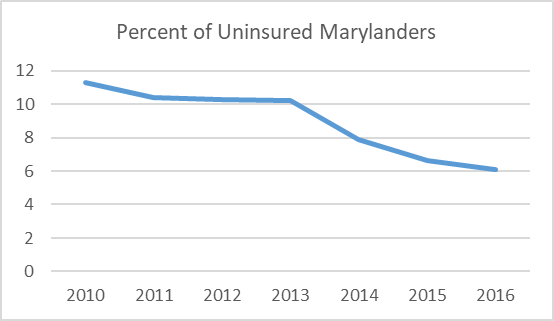More Marylanders have health insurance, but federal actions threatens these gains
The percentage of Marylanders with health coverage has continued to grow since the implementation of the Affordable Care Act. Just as newly released census data showed the continued gains, Senate Republicans were reinvigorating their effort to repeal the ACA, putting the strides that the U.S. has made over the past several years in granting health care coverage in jeopardy.
In 2016, 6.1 percent of Marylanders were uninsured, a significant drop from the 11.3 percent uninsured rate in 2010, the U.S. Census Bureau reports. The uninsured rate also dropped among all demographic groups in the state, including people of color, immigrants, and Marylanders with different income and education levels.
Despite the decline in the rate of uninsured, disparity between people of color, immigrants, and Marylanders of different income and education levels, has remained the same in comparison to the rest of the state.
As shown in the chart below, the uninsured rate for all Marylanders has consistently dropped since 2010, reaching a record low in 2016. However, not all Marylanders have been able to share in the increased access to healthcare coverage. Though the uninsured rate has decreased for all racial and ethnic groups, the uninsured rate for Black and Asian-Americans has consistently remained almost twice that of White Americans. For Latino Americans, the uninsured rate is three times the rate of Black and Asian Marylanders, and six times as high as Whites.
Additionally, the uninsured rate for Latinos has not decreased at the same rate as other racial and ethnic groups. The uninsured rate for Latino-Americans dropped by a third, while other racial and ethnic groups’ uninsured rates were cut in half.
The uninsured rate for Marylanders in poverty and at different education levels varied as well. For Marylanders struggling to make ends meet with incomes below the federal poverty line ($30,750 for a family of four), the uninsured rate is at 12.4 percent, twice the statewide rate. The uninsured rate for Marylanders of different education levels fell disproportionately as well. For Marylanders with a high school education or above, the uninsured rate dropped over 40 percent, while the rate for Marylanders with less than a high school education dropped by 20 percent.
The ACA has been instrumental in helping more Marylanders gain access to health coverage. Congressional Republican’s efforts to repeal and replace the ACA, such as the Cassidy-Graham bill and the House draft budget resolution, would cause millions of people to lose coverage by restructuring and deeply cutting Medicaid, eliminating or weakening protections for people with pre-existing conditions, and increasing out-of-pocket costs for people buying insurance on the individual market.
In short, the Cassidy-Graham bill would do the following:
- Eliminate the ACA’s premiums and cost sharing subsidies and enhanced matching rate for the Medicaid expansion and replace them with an inadequate block grant. The Market-Based Health Care block grant would be below current federal funding for coverage, would not adjust based on need, would disappear altogether after 2026, and states could spend it on any health care purpose, with no requirement to offer working families coverage or financial assistance.
- Convert Medicaid’s current federal-state financial partnership to a per capita cap, which would cap and cut federal Medicaid per-beneficiary funding for seniors, people with disabilities, and families with children. This would result in $10-50 billion federal funding cuts for Maryland between 2020 and 2026.
- Eliminate or weaken protections for people with pre-existing conditions by allowing states to waive the ACA’s prohibition against charging higher premiums based on health status and the requirement that insurers cover essential health benefits.
Together, these changes result in even larger coverage losses than under prior proposals to repeal ACA’s major coverage provisions without replacement. The Congressional Budget Office (CBO) has previously estimated that repealing the ACA without replacing it would cause 32 million people to lose coverage. The Cassidy-Graham bill would likely lead to greater numbers of uninsured after 2026, as it would eliminate ACA’s major coverage expansions and make severe federal funding cuts to the rest of the Medicaid program under its per capita cap. While the Cassidy-Graham bill does not currently have enough support to pass the Senate, there remains interest in Congress in passing similar legislation.
Maryland has made significant strides in reducing the number of uninsured Marylanders and we can’t afford to take a step backwards. Federal healthcare reforms need to focus on improving healthcare coverage – for example by taking steps to stabilize the insurance marketplaces – not reducing it.

